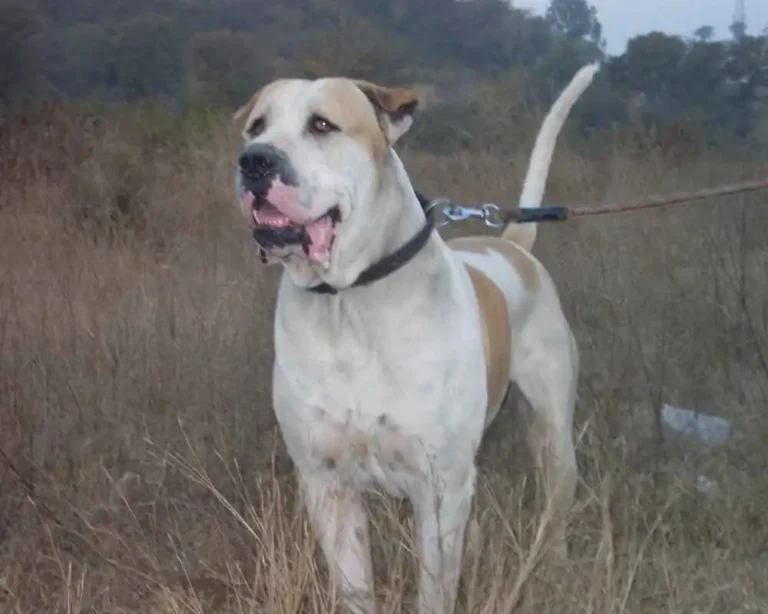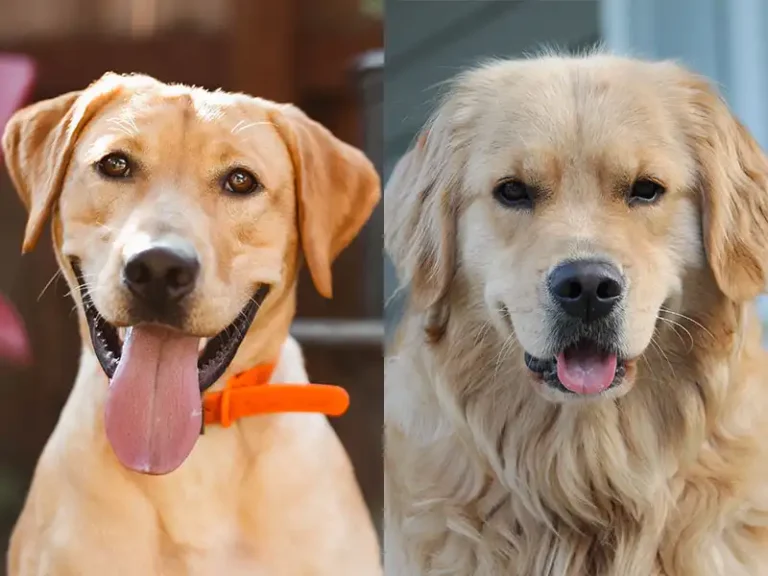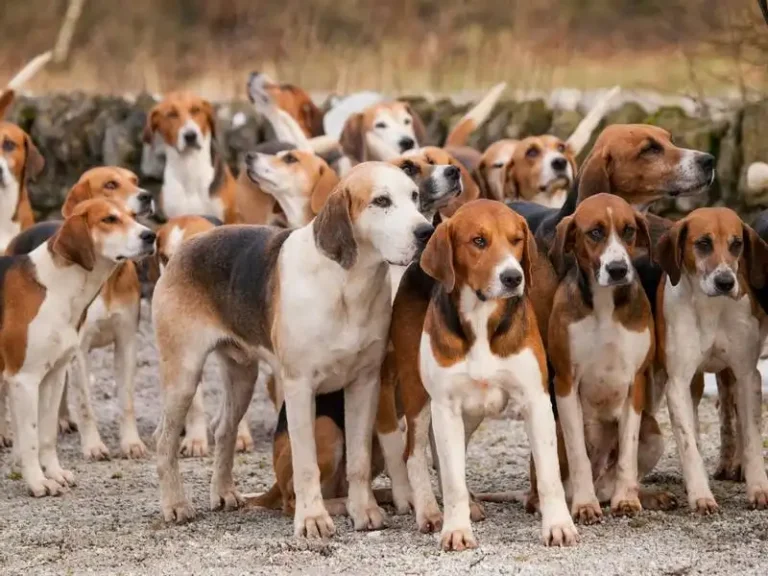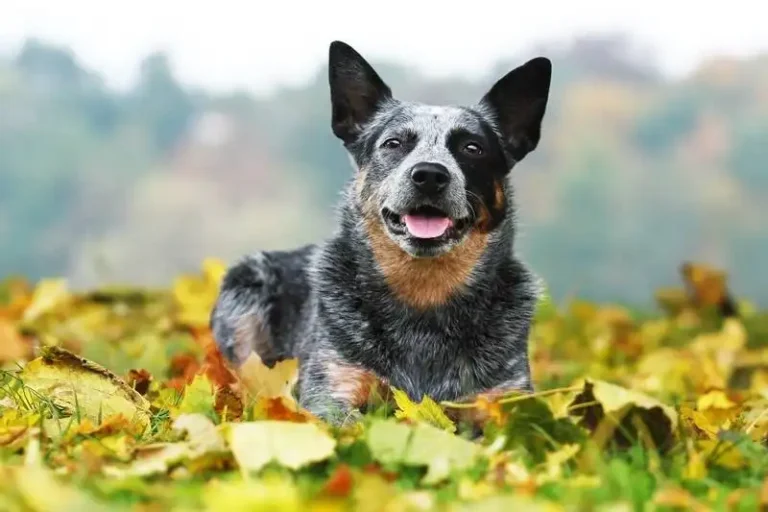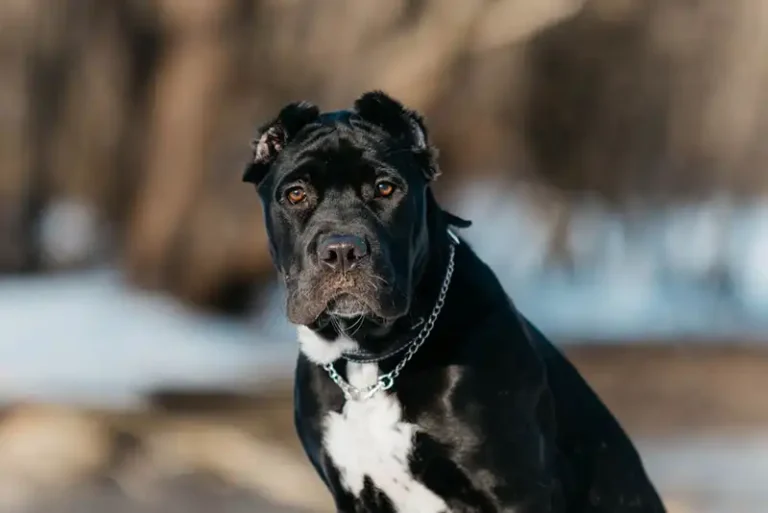Basic information about the Boston Terrier
Boston Terriers have been the official state dog of Massachusetts since 1979.
Dogs have quite a developed facial expression; they can make faces.
At first glance, the breed is very similar to the French bulldog, for a non-specialist it is difficult to distinguish them. In fact, the dogs have many differences – the shape of the ears, eyes, body.
Unlike other brachycephalic dogs, they do not salivate as much. Owners consider this feature of Boston Terriers to be a significant plus.
Perfect for keeping in a city apartment. The breed will be an excellent companion for a person of any age.
Dogs have a high level of intelligence. They quickly learn new commands, are very obedient and ready to please their owner in everything.
Since the digestive system of Boston Terriers can react sharply to an improperly formulated diet (flatulence appears), the animal’s nutrition must be carefully monitored.
Country of origin: USA
Size: medium
Height: 38-43 cm
Weight: 7-11 kg
Age: 15 years
FCI breed group: toy and companion dogs
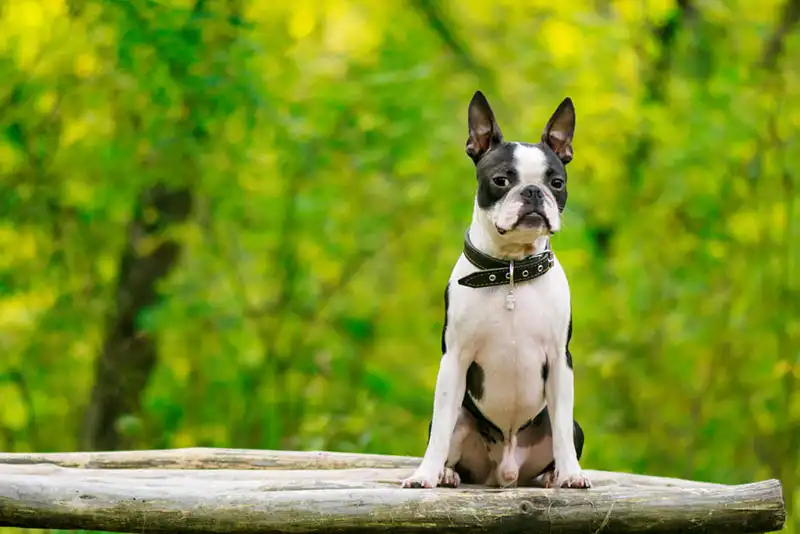
Historical background
The Boston Terrier is one of the few dog breeds that originated in America. Boston has always been considered the second unofficial capital of the United States, and was one of the richest and oldest cities in the country. The formation of the breed began in the 19th century.
The history of the creation of American terriers has been almost completely studied by researchers and has no “blank spots” like other very ancient breeds.
Bostons were not bred on purpose, it happened completely by accident. The first breeder of animals was Robert Hupper. A brindle-colored dog named Judge (translated from English – judge) came to him in 1870. According to one version, he bought it himself in the seaport, according to another – the dog was sold to him by his friend William O’Brien. He was a typical crossbreed for that time, descended from English bulldogs and English terriers. In the 19th century in England they were used as hunting and fighting dogs.
Judge was quite large. He weighed about 15 kilograms.
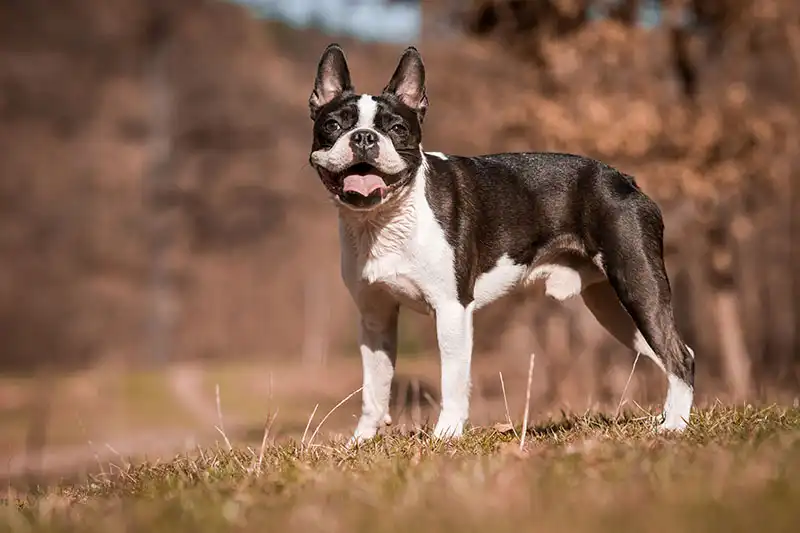
A cross between a Hooper dog and a white bulldog female named Barneta occurred by chance. The offspring were of the same type, very similar to their father. It was these individuals who later began to participate in breeding work, as a result of which animals with more rounded heads were obtained. To infuse new blood into the work, French bulldogs , bull terriers , pit bulls and boxers were brought in . Initially, the resulting breed was called American or Boston bulls.
For the first time at the exhibition in Boston such dogs were demonstrated in 1878. It was after this event that their popularity began to grow. The breed became especially popular by the 20s of the 20th century. At that time, the pets were nicknamed “gentlemen from Boston”.
The first Club was organized in 1891, and the standard was written that same year. Boston Terriers were recognized as a separate breed in 1893.
After World War II, the dogs came to Europe and then to Great Britain. Nowadays, they are not considered a very popular breed, and the largest number of Boston breeders are still in the United States.
Description of the Boston Terrier
The Boston Terrier is a medium-sized pet. The dog looks compact and harmoniously built. The distinctive feature of the breed is a short head. The body does not look stretched, it is tight and strong.
According to the standard, the following colors are allowed: brindle, seal, black. White markings are mandatory. The skin is smooth, without folds, including on the muzzle.
The sexual type is clearly expressed. Females are distinguished by a more graceful skeleton and a refined silhouette.
Head
The Boston Terrier’s skull is square. The forehead looks flat, and folds are unacceptable. The cheekbones look flat. The superciliary arches are distinct. The muzzle is quite massive, but short. The stop is clearly visible.
The nose is large and black. A light nose is considered a significant fault. The groove between the nostrils is clearly defined.
The jaws of Boston Terriers are strong and robust. Their shape is square. The teeth do not look too large. The bite is usually level. An undershot bite is acceptable. The lips are deep, and severe drooping is considered a fault.
Eyes
They are at a decent distance from each other. Their shape is round. Convexity is allowed. Color is predominantly dark. The outer corner of the eyes should be at the level of the cheeks. Disqualifying faults include blue eyes, completely or partially.

Ears
They are small in size in the Boston Terrier. They are located very close to the corners of the skull. The hair on them is short, the inside of the ear is bald.
Neck
Its length is fully proportional to the dog’s build. It looks slightly convex. It is set high. The dog carries its head proudly. The transition to the withers is smooth. The hair on the neck is short but dense.
Frame
The Boston Terrier has a compact appearance. The back is short, making the dog’s body look almost square. The topline is straight. The croup is slightly sloping. The chest is deep and wide. The ribs are rounded, the false ribs are elongated.
Tail
The tail is short. Set rather low. Wide at the base, tapering towards the end. A vertically raised tail is considered a fault. It does not rise above the line of the back. Docking is prohibited.
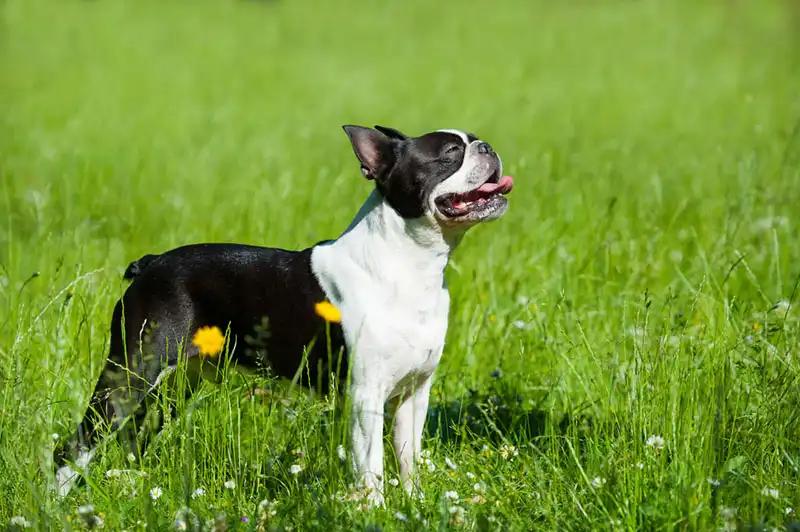
Limbs
The limbs of the Boston Terrier are straight, parallel to each other. The elbows are directed backwards and should not protrude too much.
The paws are small and round in shape. The toes are compact with moderately long claws.
The thighs of Boston Terriers look strong. The muscles are well defined. The hocks are low, their angles are clearly defined. Straight stifles are considered a significant defect.
Gait
The Boston Terrier moves confidently and freely. When running or walking, the front and back legs move parallel. A gait resembling a horse’s stride is a defect. Crossing movements of the legs are also highly undesirable.
Wool cover
This breed is allowed to have only short hair. It is smooth and lies close to the dog’s body. Boston Terriers do not have an undercoat. A healthy dog has shiny and silky hair.
The Boston Terrier must have white markings. The seal color looks like black with a red tint. The tint is especially noticeable in very bright sunlight or artificial lighting.
White spots are present on the muzzle (in the form of a border around the muzzle or a stripe between the eyes), there is a “collar” on the neck and on the limbs.
Any solid color in Boston Terriers is considered a fault.
Size and weight
The average height is from 38 to 43 cm. By weight, representatives of this breed are divided into three groups: large (9-11 kg), standard (7-9 kg) and mini (up to 7 kg).
Boston Terrier Personality
Boston Terriers are dogs with a cheerful character. Aggression is not typical for them. These animals are affectionate to all people, including strangers. They will greet all guests of their home with great joy. Their guard qualities are average. If the dog senses danger, it will most likely warn the owner with loud barking, but it is unlikely to attack without an apparent reason.
Boston Terriers were not called “Boston gentlemen” for nothing. They behave extremely reservedly and politely. They do not bother their owner unnecessarily, do not demand constant attention to their person, and do not bark without reason.
The pet’s small size and weight allow you to take it with you almost everywhere. Boston Terriers love car rides, they will happily watch what is happening outside the car window.
They treat children with love. They love active games . They will support any children’s activity: hide-and-seek, tag, swimming in the river. Boston Terriers are very energetic and active.
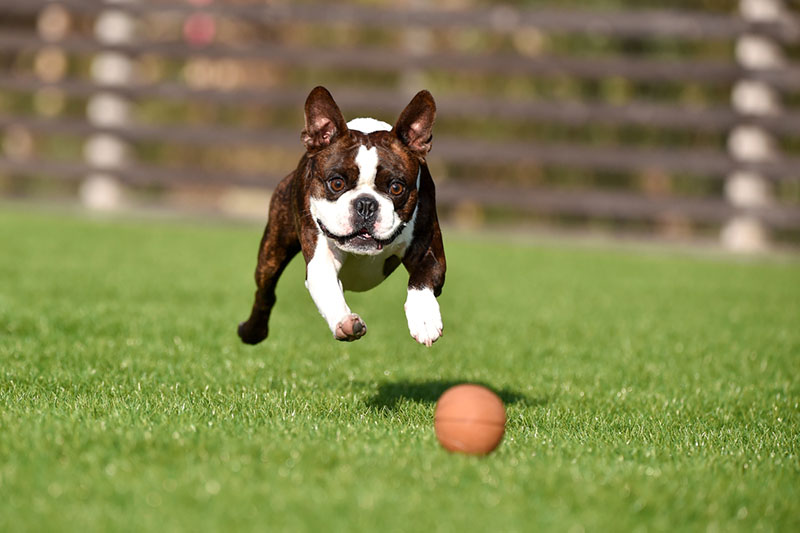
They are tolerant of other pets and can easily get along with cats, birds, rodents. They behave very friendly with their relatives on the walking area, they try not to get into conflicts. They easily make contact with other dogs, their tendency to dominate is moderate.
This breed needs human interaction. Boston Terriers are very sensitive to the owner’s mood, they subtly sense the tone of the voice, and watch the facial expressions of a person.
They are very obedient, so they are quite suitable for beginner dog lovers. They are easy to train. The dog strives to please its owner in everything and is ready to carry out all his orders. They have a good memory, they learn commands quite quickly.
Quite active. Of course, not like Jack Russell Terriers , but ready to support active games: football, running with obstacles.
Education and training
Enough time is devoted to training a dog of any breed. Training should not only be systematic, but also start on time. It is wrong to think that a puppy does not need training. You can start training it in the first days of its appearance in your home.
At first, training sessions are very short – 10-15 minutes. As you grow older, the time increases.
It is not recommended to immediately begin to master commands; to begin with, you can teach the baby a basic set of skills: getting used to your sleeping place, dishes, and nickname.
The name is chosen to be simple, easy to pronounce for the owner. A long nickname is undesirable, it is better if it consists of 1-2 syllables. For animals purchased from a nursery and already having a passport, a shortened version of an existing name is usually invented. After all, most often for dogs with pedigrees it is very complex and intricate.
Some people are ready to put up with the fact that the dog will sleep on the owner’s bed, for others it is completely unacceptable. Such boundaries need to be established from puppyhood. It is wrong to think that at first you can let the baby on your bed, and then, when he grows up a little, start to forbid him to do this. Prohibitions must be established once and for all, and all family members must comply with them.
The arrival of a new family member – a puppy – is usually prepared in advance. They buy him a collar , a leash, his own dishes, a bed . In order for the baby to adapt to the new home faster, it is recommended to take from the breeder several things that will remind him of his mother, that is, have her smell. These can be toys or diapers. If this is not possible, then special pheromones are purchased, for example, Adaptil. They contain a synthetic analogue of mother’s milk.
During training, it is unacceptable to use physical force or shout loudly at your pet. Dogs are guided by gestures and changes in a person’s tone. Therefore, to express your dissatisfaction, it will be enough to slightly raise the tone of your voice, for example, to say loudly and clearly: “No!” or “You can’t!”
After the puppy has mastered basic skills, you can begin studying the general training course. Boston Terriers are distinguished by their intelligence and high level of intelligence. They learn new information quite quickly. Most often, even beginners do not have problems with them.
The basic set of commands includes: “Next”, “Lie down”, “Stand”, “Sit”, “Come to me”, “Place”.
Maintenance and care
This medium-sized dog will feel good in a small apartment, it does not require much space. In a country house, the dog also feels great, but, of course, such animals are not placed in an enclosure .
Boston Terriers are considered to be quite energetic breeds. But their activity level can be described as moderate. Regular physical exercise is important for them to maintain their shape and release accumulated energy, but they have difficulty withstanding too long training sessions: they begin to breathe heavily, snort, and sniffle. They need to be given time to rest periodically.
Boston Terriers have proven themselves to be good athletes, they successfully participate in agility and frisbee. They need regular walks, however, it is imperative to pay attention to the weather – dogs are afraid of severe frost and excessive heat. In winter, it is advisable to dress them in special clothing.
They include: nail trimming, ear and teeth cleaning, bathing, combing. Training occurs gradually, not all dogs allow such manipulations to be carried out on themselves the first time without any obstacles. Most often, after several procedures, the dog begins to react more calmly.
The Boston Terrier’s short and smooth coat does not require very frequent care. It will be enough to brush it once a week with a rubber glove or brush. This breed sheds very moderately. Brushing is used not only to remove excess hair, but also as a massage, which improves blood circulation and removes dust and dirt from the coat, promoting the growth of new hair.
The dog’s paws should be examined after each trip outside. In the summer, daily washing of paws is not required, but in the winter, using warm water and soap, you will need to clean the paws from the reagents that are sprinkled on the road in cities. If this is not done, irritation will appear on the pads.
You can brush your dog’s teeth every day, just like you would a human’s. This will help prevent your pet from developing plaque and tartar. If you don’t want to do this, you can use dental treats to remove plaque, which not only help get rid of plaque, but also massage the gums, improving blood circulation.
To cleanse the eyes from dirt and mucus, special veterinary lotions are used. It is also acceptable to use ordinary warm water.
The animal’s ears need to be cleaned regularly – 1-2 times a week. If signs of inflammation appear, you should see a doctor.
Boston Terriers are not bathed often – usually once a month is enough. For washing, it is advisable to purchase special shampoos for dogs. During the hygienic procedure, be sure to monitor the water temperature (it should be 37-39 degrees) and to ensure that the product does not get into the eyes and ears.
Regular and high-quality hygiene affects not only the appearance of the animal, but also ensures its health for many years.
Boston Terrier Nutrition
The quality of the food consumed directly affects the condition of the pet. An incorrectly selected diet can lead to the appearance of various diseases: from a banal digestive disorder to serious health problems.
Owners can choose one of the following types of food for their pets: natural products, ready-made veterinary food (dry or wet).
The simplest option is ready-made rations. Among them, there are complete and incomplete feeds. The former contain all the necessary substances, including vitamins and minerals. The latter need to be supplemented separately with vitamin complexes. Only a veterinarian can prescribe such supplements.
Natural feeding takes a lot of effort and extra time from the owner. It is necessary to buy a large volume of products and cook them yourself. The balance of proteins, fats and carbohydrates in this case should be calculated by a nutritionist. It is very difficult to cope with the calculation on your own. When choosing this type of food, you should always pay attention to the purchased products: they must be high-quality and fresh. Dogs can be given lean meats, cereals, potatoes, sweet potatoes, pasta. Vegetable and salmon oil are most often used as a source of fat.
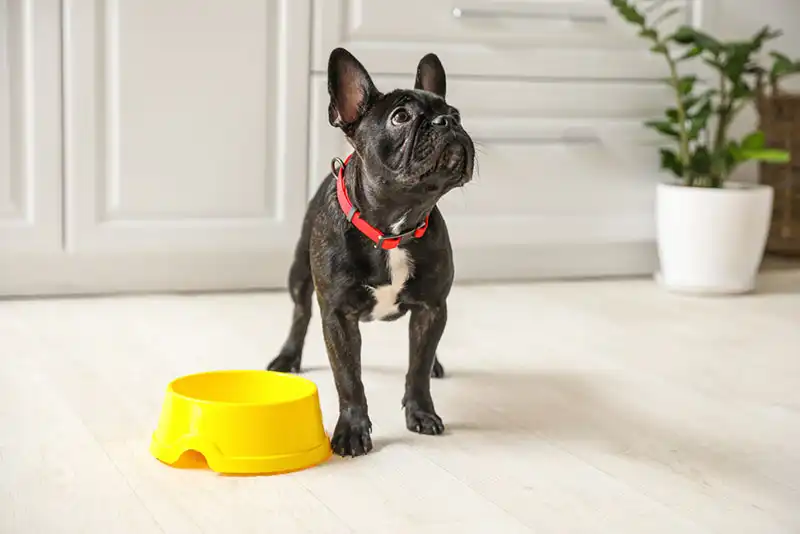
With any type of feeding, the basis of the pet’s diet is protein, since the dog is a carnivorous animal. Carbohydrates are also present, but in small quantities.
In no case should you feed your pet from the human table. It has its own bowl, which, after the meal is over, must be removed until the next meal. The dog only has access to water. Feeding in large quantities can lead to serious health problems, in particular obesity.
The frequency of feeding may vary for each pet, but it is desirable for the dog to eat 2 times a day. Some animals only need one meal. Puppies always eat often – from 3 to 5 times a day.
Every owner must remember that certain types of human food are not only unhealthy for the pet, but also extremely harmful. Such products include: raw fish and meat, bones, grapes, chocolate, onions, garlic.
Offal, in particular liver, should be present in the diet in limited quantities, since they contain a lot of vitamin A, an excess of which leads to problems with cartilage tissue.
Health
Representatives of the Boston Terrier breed are prone to the following types of genetic diseases:
Eye diseases;
Deafness;
Dislocation of the patella;
Heat stroke.
Because of the special shape of the muzzle, the Boston Terrier does not feel well in extremely hot and cold weather. That is why owners need to constantly monitor the weather conditions and not take the dog out for a long walk if they are not suitable.
The digestive system of dogs is quite sensitive. An incorrectly selected diet can result in the appearance of flatulence for the animal .
Eyes need constant monitoring. Some owners prefer to carry special salt drops with them everywhere, which help to promptly clean the pet’s eyes from dust and dirt. This will help prevent the development of various eye diseases. If you notice that your Boston Terrier’s eyes have become red, irritation has appeared, contact a veterinary clinic to find out the cause of what happened.
Many Boston Terriers are prone to nighttime snoring and reverse sneezing syndrome, which can manifest itself in snorting and even gagging. Reverse sneezing does not harm the dog, it helps clear the nose of accumulated dirt and mucus. It lasts no more than 1-2 minutes.
Another problem that female Boston Terriers face is the need for a Caesarean section during labor. According to a survey by the American Kennel Club, more than 80% of females required such an operation.
Who is this breed suitable for?
- Boston Terriers are suitable for owners who dream of a dog:
- Compact size;
- Non-aggressive and sociable;
- With large, expressive eyes;
- Possessing all the qualities of an ideal companion;
- Playful and active;
- With short hair that does not require frequent grooming.
- They will not be able to tolerate night snoring and occasional snorting;
Not ready to monitor the health of your pet (take him to an ophthalmologist, do not overheat him in the heat, protect him from the cold);
They plan to purchase an animal to keep in an enclosure.
Boston Terriers can be owned by both single people and large families. The dog does not require very active physical exercise, moderate training will be enough. Therefore, the breed is quite suitable for people who do not have the opportunity to work with their pet for a very long time. They can become an excellent companion for both a young person and an elderly person.
Boston Terriers thrive in small apartments due to their compact size. They don’t need a lot of space.
Famous Dogs
One of the most famous Boston Terriers in the world is a dog named Bruski. In 2012, he was listed in the Guinness Book of Records as the dog with the largest eyes. The diameter of each eye in Bruski is 2.8 cm. He lives in Texas, the name of his owner is Victoria Reed.
How to choose a puppy
Before buying a puppy, you should try to learn as much as possible about the characteristics of the Boston Terrier breed, its maintenance, and care. To do this, it is advisable to talk to breeders, owners, dog handlers, and visit dog shows.
If you have weighed your options and have firmly decided that a Boston Terrier is the breed that is ideal for you, then start looking for a seller.
You can buy a baby Boston Terrier in a professional nursery or from a private breeder. The first option is usually considered more reliable, since such organizations employ experienced breeders who can not only offer you a healthy dog, but also give recommendations on care, training, and feeding. Breeders who refuse to answer questions, evade answers, should alert the buyer. It is better to refuse their services.
Professional nursery workers are ready not only to tell you about the litter’s parents, but can also show them.
You should never be shy about asking questions about the baby’s parents, their health. Don’t be surprised if the nursery worker asks his own questions in response: usually such organizations care where their offspring ends up, and they are interested in the buyers’ living conditions, their experience in keeping dogs, etc.
When choosing a baby, you need to pay attention to several things: its fur should be smooth, even, without bald spots, its belly should be soft, not bloated, its eyes and ears should be clean, without signs of inflammation. Puppies are usually playful, quite active and mobile, and easily make contact with new people.
The main document of a dog is its passport . The best option is if it is of international standard. It contains basic information about the animal and its owner. It also contains notes on vaccinations and parasite treatments.
The kennel brand can be located in the groin or on the ear. This unique number helps to identify the dog if necessary. Some breeders put a chip instead of a brand.
The metric is the very first document of the dog, on the basis of which the pedigree will be subsequently drawn up. All the basic information about the animal is indicated here: breed, brand, nickname, gender, color, date of birth, as well as information about the breeder and owner.
The weak point of Boston Terriers is their eyes. They need to be cleaned regularly, and care should be taken to ensure that the dog does not injure them. In case of inflammation , contact a veterinarian immediately.
One of the most significant advantages of the breed, according to the owners, is insignificant shedding . Although twice a year – in autumn and spring – you need to be prepared for the fact that the short hair will still have to be removed. It is recommended to use a hard brush or a very powerful vacuum cleaner for this.
A Boston Terrier can be a good friend for a child. But not for a small one, but for a schoolchild – from 10 years and above.
When their owners are away from home, these dogs rarely ruin things. They find a quiet occupation for themselves, most often sleeping or just lying on the sofa.
Animals love all kinds of toys . But you should be prepared for the fact that you will have to buy them very often – thanks to the powerful jaw, the Boston gnaws them literally before your eyes.


